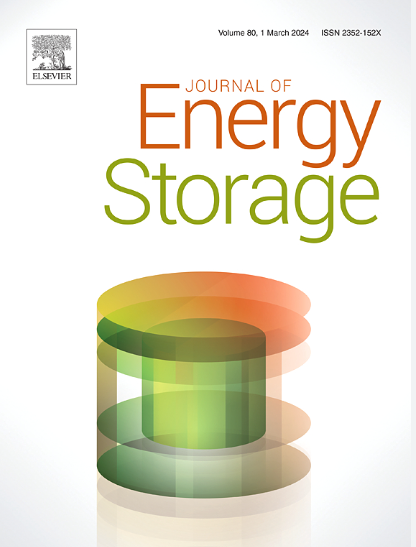研究充电参数对多硫溴化钠液流电池放电效率的影响
IF 8.9
2区 工程技术
Q1 ENERGY & FUELS
引用次数: 0
摘要
聚硫溴液流电池(PSB)是一种前景广阔的选择,因为它可以从东南亚轻松获得聚硫酸钠和溴化钠溶液等原材料。本研究集中于 PSB,旨在考察影响其充电行为的众多因素,进而影响其放电效率。研究了充电过程中的五个关键参数:受外加电流影响的反应动力学、受流速影响的传质、受电解质比率影响的化学计量学、受储存时间影响的耐久性以及受电解质体积影响的浓度梯度。这篇文章还介绍了储存期间电解质稳定性的影响,它直接影响 PSB 的电荷状态 (SOC)。研究人员对电解质的稳定性进行了监测,最初每隔一小时收集一次数据,随后在整个研究期间每隔 10 小时收集一次数据。研究将 PSB 的性能与广泛认可的钒氧化还原液流电池 (VRFB) 进行了比较。电池在充电电流为 0.15 A、流速为 20 ml min-1、电解液比例为 1:1、体积为 50 ml 时表现出最高性能。在这些条件下,放电效率比最不利条件下高 19%。本文章由计算机程序翻译,如有差异,请以英文原文为准。

Investigating impact of charging parameters on discharge efficiency of sodium polysulfide-bromide flow battery
The polysulfide-bromide flow battery (PSB) stands out as a promising option, owing to the availability of raw materials like sodium polysulfide and sodium bromide solutions, easily sourced from Southeast Asia. This investigation concentrates on the PSB, with the aim of inspecting the numerous factors that influence its charge behavior, subsequently affecting its discharging efficiency. Five critical parameters of charging process underwent investigation: reaction kinetics affected by applied current, mass transfer influenced by flow rate, stoichiometry impacted by electrolyte ratio, durability influenced by storage time, and concentration gradient influenced by electrolyte volume. This article also presented the influence of electrolyte stability during storage, which directly impacts the state of charge (SOC) of the PSB. The stability of electrolytes was monitored, with data collected at hourly intervals initially and subsequently at 10-hour intervals throughout the study period. The research examines the performance of PSB in comparison with the widely recognized Vanadium Redox Flow Battery (VRFB). The battery exhibited its highest performance when charged with a current of 0.15 A, a flow rate of 20 ml min−1, an electrolyte ratio of 1:1, and a volume of 50 ml. Under these conditions, the discharge efficiency was 19 % higher compared to the least favorable condition.
求助全文
通过发布文献求助,成功后即可免费获取论文全文。
去求助
来源期刊

Journal of energy storage
Energy-Renewable Energy, Sustainability and the Environment
CiteScore
11.80
自引率
24.50%
发文量
2262
审稿时长
69 days
期刊介绍:
Journal of energy storage focusses on all aspects of energy storage, in particular systems integration, electric grid integration, modelling and analysis, novel energy storage technologies, sizing and management strategies, business models for operation of storage systems and energy storage developments worldwide.
 求助内容:
求助内容: 应助结果提醒方式:
应助结果提醒方式:


